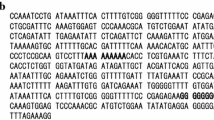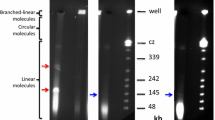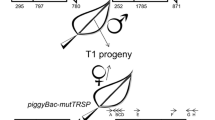Abstract
Plastid transformation is conducted by homologous recombination. Plastid transformation using a vector-containing promoter and/or terminator sequences homologous to the plastid DNA for transgene expression often results in the generation of unintended extrachromosomal DNA molecules derived from the initial plastid DNA molecule via intramolecular recombination. All the extrachromosomal DNA molecules, including those lacking the ori sequence, found in the T0 plastid-transformed tobacco plants were still detected in the T3 plants. These results suggest that the extrachromosomal DNA molecules are newly generated from the initially transformed plastid DNA that is transmitted to the progeny during each generation. In addition, inward, outward, and overlap extension PCR of the extrachromosomal DNA molecules confirmed that these molecules were circular.






Similar content being viewed by others
References
Corneille S, Lutz KA, Azhagiri AK, Maliga P (2003) Identification of functional lox sites in the plastid genome. Plant J 35:753–762
Gray BN, Ahner BA, Hanson MR (2009) Extensive homologous recombination between introduced and native regulatory plastid DNA elements in transplastomic plants. Transgenic Res 18:559–572
Guda C, Lee SB, Daniell H (2000) Stable expression of biodegradable protein base polymer in tobacco chloroplasts. Plant Cell Rep 19:257–262
Karimi F, Mousavi A, Salmanian AH, Alizadeh H, Rafati S (2013) Immunogenicity of EIT chimeric protein expressed in transplastomic tobacco plants towards development of an oral vaccine against Escherichia coli O157:H7. Plant Biotechnol Rep 7:535–546
Klaus SMJ, Huang FC, Golds TJ, Koop HU (2004) Generation of marker-free plastid transformants using a transiently cointegrated selection gene. Nat Biotechnol 22:225–229
Lilly JW, Havey MJ, Jackson SA, Jiang J (2001) Cytogenomic analyses reveal the structural plasticity of the chloroplast genome in higher plants. Plant Cell 13:245–254
Maliga P (2004) Plastid transformation in higher plants. Ann Rev Plant Biol 55:289–313
Min SR, Davarpanah SJ, Jung SH, Park YI, Liu JR, Jeong WJ (2015) An episomal vector system for plastid transformation in higher plants. Plant Biotechnol Rep (Submitted)
Murashige T, Skoog F (1962) A revised medium for rapid growth and bioassays with tobacco tissue cultures. Physiol Plant 15:473–497
Roh KH, Choi SB, Kwak B-K, Seo S-C, Lee S-B (2014) A single cupredoxin azurin production in transplastomic tobacco. Plant Biotechnol Rep 8:421–429
Scharff LB, Koop HU (2007) Targeted inactivation of the tobacco plastome origins of replication A and B. Plant J 50:782–794
Small ID, Suffolk R, Leaver CJ (1989) Evolution of plant mitochondrial genomes via substoichiometric intermediates. Cell 58:69–76
Staub JM, Maliga P (1992) Long regions of homologous DNA are incorporated into the tobacco plastid genome by transformation. Plant Cell 4:39–45
Staub JM, Maliga P (1994) Extrachromosomal elements in tobacco plastids. Proc Natl Acad Sci USA 91:7468–7472
Acknowledgments
This work was supported by a grant from the KRIBB Research Initiative program, a Grant from the Advanced Biomass R&D Center (ABC) of Korea Grant funded by the Ministry of Education, Science and Technology (ABC-2011-0031343), and a Grant from the Golden Seed Project, Ministry of Agriculture, Food, and Rural Affairs (MAFRA), the Ministry of Oceans and Fisheries (MOF), Rural Development Administration (RDA), and Korea Forest Service (KFS).
Author information
Authors and Affiliations
Corresponding authors
Additional information
J. R. Liu and W.-J. Jeong contributed equally to this work.
Electronic supplementary material
Below is the link to the electronic supplementary material.
Rights and permissions
About this article
Cite this article
Min, S.R., Jung, S.H., Liu, J.R. et al. The fate of extrachromosomal DNAs in the progeny of plastid-transformed tobacco plants. Plant Biotechnol Rep 9, 431–442 (2015). https://doi.org/10.1007/s11816-015-0380-5
Received:
Accepted:
Published:
Issue Date:
DOI: https://doi.org/10.1007/s11816-015-0380-5




